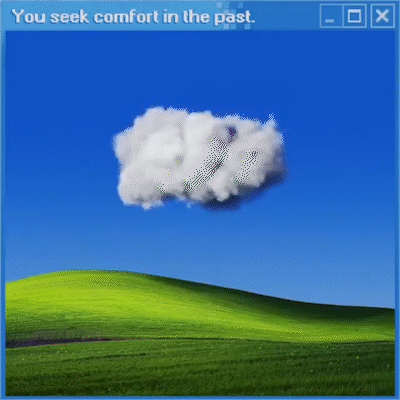This post unpacks ideas explored in the latest VU JA DE installment, Pennies From Heaven.
While I typically try to supplement these videos with some writing, in this case I found that many compelling and well-researched works already exist. So for everyone’s sake, I’ll just share those.
What follows is an assortment of my key influences on this project, which may also make for fruitful starting points in your own further explorations. Enjoy!
“Beginning in the 1950s, a new symbol began to creep into the diagrams drawn by electrical engineers to describe the systems that they built. The system was a fuzzy circle, or a puffball, or a thought bubble. Eventually the form settled on a cloud. . . . The cloud was a way of reducing complexity: it allowed [the engineer] to focus on the near at hand, and not worry about what was happening over there . . . it became a business buzzword and a selling point. It became more than engineering shorthand; it became a metaphor.”
— James Bridle, New Dark Age
"While in technical parlance the “Cloud” might refer to the pooling of computing resources over a network, in popular culture, “Cloud” has come to signify and encompass the full gamut of infrastructures that make online activity possible, everything from Instagram to Hulu to Google Drive. Like a puffy cumulus drifting across a clear blue sky, refusing to maintain a solid shape or form, the Cloud of the digital is elusive, its inner workings largely mysterious to the wider public, an example of what MIT cybernetician Norbert Weiner once called a “black box.” But just as the clouds above us, however formless or ethereal they may appear to be, are in fact made of matter, the Cloud of the digital is also relentlessly material. . . . [In fact], the Cloud now has a greater carbon footprint than the airline industry."
— Steven Gonzalez Monserrate, The Cloud Is Material: On the Environmental Impacts of Computation and Data Storage
“The cloud is not weightless; it is not amorphous, or even invisible, if you know where to look for it. The cloud is not some magical faraway place, made of water vapour and radio waves, where everything just works. It is a physical infrastructure consisting of phone lines, fibre optics, satellites, cables on the ocean floor, and vast amounts of warehouses filled with computers, which consume huge amounts of water and energy and reside within national and legal jurisdictions. The cloud is a new kind of industry, and a hungry one. The cloud doesn’t have a shadow; it has a footprint. Absorbed into the cloud are the many weighty edifices of the civic sphere: the places where we shop, bank, socialism, borrow books, and vote. Thus obscured, they are rendered less visible and amenable to critique, investigation, preservation and regulation.”
— James Bridle, New Dark Age
“The Cloud is made of rare earth. Lamps in video games use real electricity. In cyberspace, we’re constantly swimming in simulations . . . that make it all too easy to forget about the geological “stack” that undergirds our virtual hall of mirrors.”
— Aaron Z. Lewis, The Garden of Forking Memes
"Put simply: each small moment of convenience – be it answering a question, turning on a light, or playing a song — requires a vast planetary network . . . from indentured labor in mines for extracting the minerals . . . to the work of strictly controlled and sometimes dangerous hardware manufacturing and assembly processes in Chinese factories; to exploited outsourced cognitive workers in developing countries labelling AI training data sets; to the informal physical workers cleaning up toxic waste dumps."
— Kate Crawford & Vladan Jole, Anatomy of an AI System
"The cloud presupposes a geography where data centers can be built. It presupposes an environment protected and stable enough for its server farms to be secure, for its operations to run smoothly and uninterrupted. It presupposes redundant power grids, water supplies, high-volume, high-speed fiber-optic connectivity, and other advanced infrastructure. It presupposes cheap energy, as the cloud’s vast exhaust violates even the most lax of environmental rules. While data in the cloud may seem placeless and omnipresent, precisely for this reason, the infrastructure safeguarding its permanent availability is monstrous in size and scope."
— Metahaven, Captives of the Cloud: Part II
"All that information―all that information capacity―looms over us, not quite visible, not quite tangible, but awfully real; amorphous, spectral; hovering nearby, yet not situated in any one place. Heaven must once have felt this way to the faithful."
— James Gleick, The Information: A History, a Theory, a Flood
“An ecological understanding allows us to identify “things”—rain, cloud, river—at the same time that it reminds us that these identities are fluid. Even mountains erode, and the ground below us moves in giant plates. It reminds us that—while it’s useful to have a word for that thing called a cloud—when we really get down to it, all we can really point to is a series of flows and relationships that intersect and hold together long enough to be a “cloud.”
— Jenny Odell, How to Do Nothing: Resisting the Attention Economy
Still hungry?
Films
Media-rich articles
Essays








